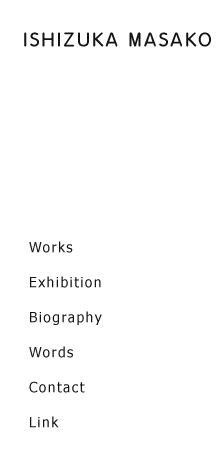■
Masako Ishizuka’s Paintings - Yusuke Nakahara, Art Critic
Among paintings being created today, one trend can be described as abstract paintings that do not distinctly reproduce existing forms, but which allow the viewer to recall some image. Most of these paintings present organic forms, such as the fragments of a plant, even though they could not exactly be specified as a plant.
Masako Ishizuka’s paintings also allow us to recall forms that are seemingly strikingly familiar. But if we were to be asked what exactly those forms might be, we would not know for sure. For example, one of her works might remind viewers of the image of flowing, swirling water, but this image would not seem exactly right. We might also imagine something like the fragments of a bone, but feel that that might not be quite right either.
We do not particularly have to discover any existing form in this type of painting; we could just rationally consider that the painting is an abstract expression. If we were to follow the ‘abstract painting’ way of interpreting Ishizuka’s work, it would be that her work is composed of circular or ovular forms that are combined with spinning forms. In addition, the color of her work is basically monochromatic. I might also add that movement can be perceived from the way she paints color and her linear depictions; these elements can be indicated as creating dynamism on the surface.
Two artistic currents are merged in Ishizuka’s work: Abstract Expressionism and New Painting. The organic forms found in her paintings echo back to Abstract Expressionism, while the way those forms are depicted contain an element of New Painting. If this type of expression is considered an artistic trend, it could be described as “New Abstract in the Post-New Painting.”
Among such a New Abstract-style of work, Ishizuka’s acrylic and oil-stick-based paintings are, as I have mentioned, characterized by the use of a single color rather than various colors, and achieve the generation of formative and linear movements. The surface of her painting that unifies the color field (through the use of acrylic paint) with the depicted lines (created with oil sticks) can also be described as harmonizing ‘painting’ and ‘drawing.’ This successful creation of harmony reveals her great artistic talent and skill.
From the point of view that her new works in this exhibition juxtapose circular forms and spinning forms, they are similar to her former works. But by increasing the number of forms, her new works convey a strong sense of horizontal expansion. This might also be an indication that her works are about to undergo further transformation. However, her new works still possess the characteristic that allows viewers to recall some kind of image. Ishizuka’s paintings that at first glance appear to be simple depictions contain, in fact, profound substance.
Japanese essay was reprinted from “INAX ART NEWS: Masako Ishizuka Exhibition,” May 1993
(Translated by Taeko Nanpei)
Among paintings being created today, one trend can be described as abstract paintings that do not distinctly reproduce existing forms, but which allow the viewer to recall some image. Most of these paintings present organic forms, such as the fragments of a plant, even though they could not exactly be specified as a plant.
Masako Ishizuka’s paintings also allow us to recall forms that are seemingly strikingly familiar. But if we were to be asked what exactly those forms might be, we would not know for sure. For example, one of her works might remind viewers of the image of flowing, swirling water, but this image would not seem exactly right. We might also imagine something like the fragments of a bone, but feel that that might not be quite right either.
We do not particularly have to discover any existing form in this type of painting; we could just rationally consider that the painting is an abstract expression. If we were to follow the ‘abstract painting’ way of interpreting Ishizuka’s work, it would be that her work is composed of circular or ovular forms that are combined with spinning forms. In addition, the color of her work is basically monochromatic. I might also add that movement can be perceived from the way she paints color and her linear depictions; these elements can be indicated as creating dynamism on the surface.
Two artistic currents are merged in Ishizuka’s work: Abstract Expressionism and New Painting. The organic forms found in her paintings echo back to Abstract Expressionism, while the way those forms are depicted contain an element of New Painting. If this type of expression is considered an artistic trend, it could be described as “New Abstract in the Post-New Painting.”
Among such a New Abstract-style of work, Ishizuka’s acrylic and oil-stick-based paintings are, as I have mentioned, characterized by the use of a single color rather than various colors, and achieve the generation of formative and linear movements. The surface of her painting that unifies the color field (through the use of acrylic paint) with the depicted lines (created with oil sticks) can also be described as harmonizing ‘painting’ and ‘drawing.’ This successful creation of harmony reveals her great artistic talent and skill.
From the point of view that her new works in this exhibition juxtapose circular forms and spinning forms, they are similar to her former works. But by increasing the number of forms, her new works convey a strong sense of horizontal expansion. This might also be an indication that her works are about to undergo further transformation. However, her new works still possess the characteristic that allows viewers to recall some kind of image. Ishizuka’s paintings that at first glance appear to be simple depictions contain, in fact, profound substance.
Japanese essay was reprinted from “INAX ART NEWS: Masako Ishizuka Exhibition,” May 1993
(Translated by Taeko Nanpei)
May 1993
